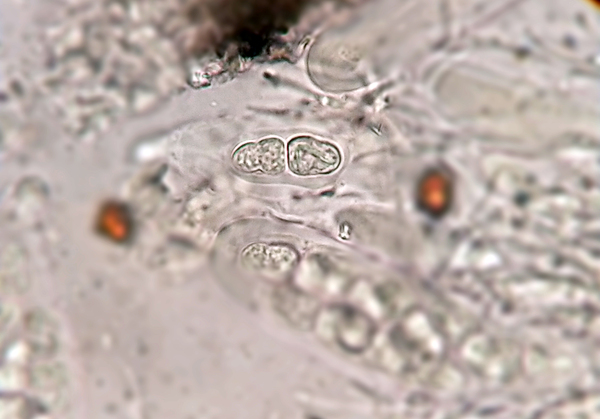Alloarthopyrenia italica Phukhams., Camporesi, Ariyaw. & K.D. Hyde
in Hyde & al., Fungal Diversity, 80: 135, 2016
Synonyms: Arthopyrenia cinereopruinosa auct. non (Schaer.) A. Massal.
Distribution: N - VG, Frl (TSB 5924), Ven (Lazzarin 2000b), TAA (Nascimbene & al. 2007b), Lomb, Piem (Isocrono & al. 2004), VA (Piervittori & Isocrono 1999), Emil (Fariselli & al. 2020), Lig (Ravera & al. 2016b). C - Tosc, Marc (Nimis & Tretiach 1999), Umb (Ravera & al. 2006, 2006b), Laz (Ravera & Genovesi 2008, Ravera & al. 2016b), Abr (Nimis & Tretiach 1999), Mol (Ravera & Genovesi 2010, Ravera & al. 2010), Sar (Rizzi & al. 2011, Di Nuzzo & al. 2022). S - Camp (Nimis & Tretiach 2004, Garofalo & al. 2010, Catalano & al. 2016, Ravera & al. 2016b), Pugl, Bas (Bartoli & Puntillo 1998, Nimis & Tretiach 1999, Potenza 2006, Potenza & al. 2010, Ravera & al. 2016b), Cal (Puntillo 1996, Incerti & Nimis 2006), Si (Nimis & al. 1994).
Description: Thallus crustose, inconspicuous or slightly bleaching the bark, whitish grey, non-lichenized, without a prothallus. Perithecia black, circular or ellipsoid in outline, (0.2-)0.3-0.45 x 0.2-0.3(-0.4) mm, when young often covered by a thin layer of bark cells which gives them a grey-pruinose appearance. Involucrellum dimidiate, dark brown in water, K + greenish, clypeate, of compacted hyphae and bark cells; ostiole distinct, centrally located, filled with downwardly projecting periphyses: exciple 40-70 μm thick, pale brown; pseudoparaphyses stout, 1-1.5 μm thick, branched and anastomosing, the cells 8-16 μm long, often with elongate, oily vacuoles. Asci 8-spored, obovoid to suboblong, bitunicate, the tholus thickened, the ocular chamber up to 2-3 μm, apically rounded, 55-65 x 13-20 μm. Ascospores 1-septate, much constricted at septum, with somehow unequal cells, each cell with an obvious median constriction, hyaline, clavate to obovoid, with rounded apices, (14.5-)18-22(-24) x (5-)8-12 μm, with a 1-3 μm thick (in K), distinct perispore, the upper cell wider than the lower cell. Photobiont absent. Spot tests: all negative. Chemistry: without lichen substances. Note: a temperate early coloniser of smooth bark, found especially in clearings of deciduous woodlands, also on young twigs of e.g. Fraxinus ornus; not lichenised. This species was previously called Arthopyrenia cinereopruinosa (Thiyagaraja & al. 2021).
Growth form: Fungus
Substrata: bark
Reproductive strategy: mainly sexual
Most common in areas with a humid-warm climate (e.g. most of Tyrrenian Italy)
Pioneer species
Commonnes-rarity: (info)
Alpine belt: absent
Subalpine belt: absent
Oromediterranean belt: absent
Montane belt: extremely rare
Submediterranean belt: very rare
Padanian area: extremely rare
Humid submediterranean belt: rare
Humid mediterranean belt: very rare
Dry mediterranean belt: absent

Predictive model
Herbarium samples

Source: Keissler K. von 1938. Pyrenulaceae, Mycoporaceae, Coniocarpineae. In: Rabenhorst G L: Kryptogamen-Flora von Deutschland, Österreich und der Schweiz. 2nd, IX, Die Flechten, Abt. 1, 2. Gebr. Borntraeger, Leipzig, pp. 1-846.

Photo uploaded by P. Cannon - CC BY-SA NC - Source: http://fungi.myspecies.info/all-fungi/arthopyrenia-cinereopruinosa
Growth form: Fungus
Substrata: bark
Reproductive strategy: mainly sexual
Most common in areas with a humid-warm climate (e.g. most of Tyrrenian Italy)
Pioneer species
Commonnes-rarity: (info)
Alpine belt: absent
Subalpine belt: absent
Oromediterranean belt: absent
Montane belt: extremely rare
Submediterranean belt: very rare
Padanian area: extremely rare
Humid submediterranean belt: rare
Humid mediterranean belt: very rare
Dry mediterranean belt: absent

Predictive model
| Herbarium samples |

Source: Keissler K. von 1938. Pyrenulaceae, Mycoporaceae, Coniocarpineae. In: Rabenhorst G L: Kryptogamen-Flora von Deutschland, Österreich und der Schweiz. 2nd, IX, Die Flechten, Abt. 1, 2. Gebr. Borntraeger, Leipzig, pp. 1-846.

 INDEX FUNGORUM
INDEX FUNGORUM
 GBIF
GBIF
 DOLICHENS
DOLICHENS



















